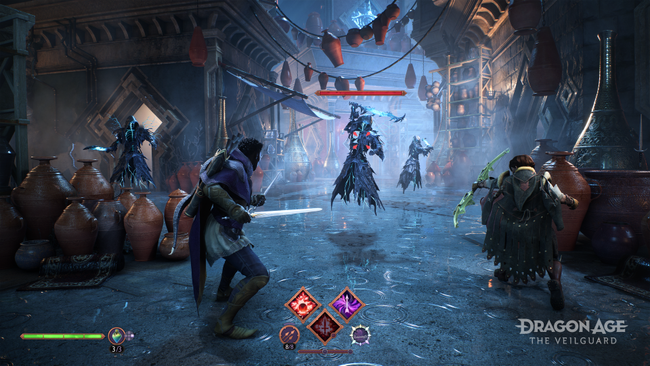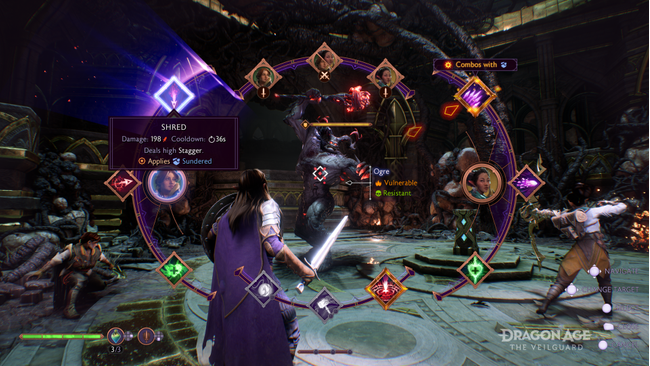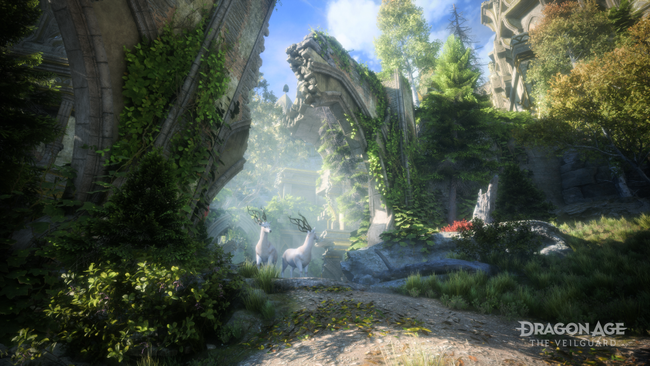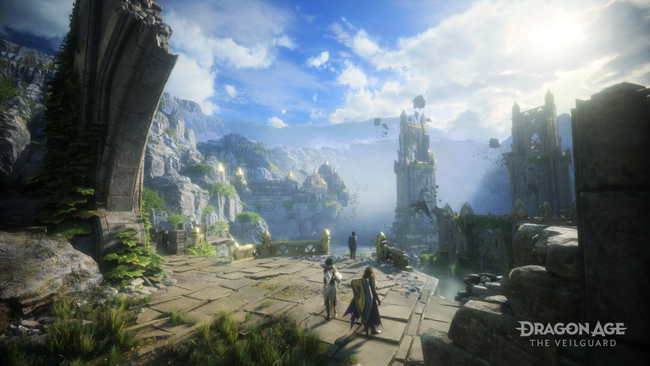
Dragon Age: The Veilguard looks to be a character-driven spectacle, but leaves uncertainty about its role-playing depth
This past weekend at Summer Game Fest Play Days, I had a chance to attend a behind-closed-doors advanced presentation where the team at BioWare showed off Dragon Age: The Veilguard for the first time.
While the newly revealed public gameplay for The Veilguard shows 20 minutes of the game's opening act, RPG Site and other attendees to Summer Game Fest 2024 got to see an extended hour-long demonstration, which included the same section of the game.

What's most immediately evident upon seeing The Veilguard is that it visually fits the part. It uses EA's Frostbite engine, just like Dragon Age: Inquisition, and a decade of technological improvements and know-how allow the newest Dragon Age to be a visual spectacle. The demo we were shown starts in Minrathous, the capital of the Tevinter Imperium, where Varric seeks out the location of Solas as he completes his ritual to remove the Veil protecting Thedas from The Fade. There's a slight stylization to the art style so that characters are not quite photorealistic, and how you take to it might solely be up to personal preference.
The private demo we saw opened up with a character creator — a component that BioWare very clearly put a lot of effort into. In fact, in our demo, we were told that one of the three key pillars of the game was 'Be Who You Want To Be.' The creator is easily the most versatile and robust that BioWare has ever had in a game before, offering numerous selections for a wide variety of body types & skin tones. BioWare seemed especially proud of both the hair-style variety and 'strand' technology used to render it so that it looks as good as possible and behaves properly in the environment.
Once you set your appearance, you pick a base class of Warrior, Rogue, or Mage just like in classic Dragon Age, and each class has three specializations that can be selected to further customize your playstyle. You pick one of six Factions for your player character (named Rook) to be a member of, which includes the Grey Wardens, Antivan Crows, or new factions like the Shadow Dragons and Veil Jumpers. As you might expect, certain backgrounds will lead to some additional dialogue at certain points in the game. In our demo, Rook was a Shadow Dragon.
After going through the character creator, the demo begins up in a bar as Varric and player-character Rook seek out Neve Gallus, a mage and member of the Shadow Dragons in Tevinter. The bar owner clearly had information we needed, but was unwilling to share it freely. We were immediately given a choice in the bar to either settle things diplomatically or through fighting. In any case, we chose to fight, which led to a fight scene (not an actual combat encounter) along with a popup noting that Varric paid attention to your choice. It's difficult to say if the other option would have been meaningfully different, although it seems like Varric's opinion of you is primarily what's at stake here.

After the bar sequence, we follow Rook & Varric as they move linearly through Minrathous, just as in the gameplay reveal posted today. They first run into Harding — now a party companion character —and later the Shadow Dragon they've been looking for in Neve Gallus. Since our Rook was also a Shadow Dragon, there was a little bit of extra dialogue here, but at this point, it was difficult to tell if it meaningfully changed anything about the character encounter, or if it was simply for a little bit of flavor.
As you make your way to Solas and his ritual site, there are a few additional moments along the linear path where you can choose affable, irreverent, or tough dialogue selections regarding the state of the city, which is currently seeing demons appear from the Fade as Solas' ritual gets closer and closer to completion. Once again, the dialogue selections primarily seem to be put in place to decide which companion character Rook most aligns with, rather than altering the path the mission would take, although it's difficult to discern.
As RPG Site, we often place extra emphasis on role-playing components and how they are incorporated into the games we cover. "Choice and Consequence" is often considered a significant component in RPGs, especially western-styled ones. In BioWare's new press release for Veilguard, they actually list out this explicitly, describing this Choice & Consequence as: "The bonds you create and the relationships you forge will be affected by your choices made throughout your journey."
To me, this reads more focused on character relationships rather than, say, quest-focused decisions that may play a part in the world or storyline otherwise, and the demo seems to reinforce that. It's very clear that BioWare is putting a lot of emphasis on its character cast and the relationships there. This is actually the second of three pillars that BioWare declared during the demo: 'Inspire A Team Of Unforgettable Heroes'.

As your newly-formed party moves closer to Solas during this cinematic tutorial mission, you encounter a few spectral demons at certain designated sections along the path. It's immediately evident that The Veilguard is leaning even more into action-based combat, as our roguish Rook started attacking demons with short blades up close and a bow from afar. The combat here is fairly up-paced, with Rook often dodging around with flips and jumps reminiscent of Arkham-style motion. There are parry-tells and all the while popups on the lower right of the screen whenever gold was picked up, which was a little distracting.
You could pause the action at any time to bring up a skill-selection menu, which shows Rook's three equipped abilities at the bottom, with three abilities for each companion on the left or right of the interface. BioWare veterans may recognize this as something similar to Mass Effect, in which while you don't control companion characters directly, you can order them to make certain actions through this interface. While there are many more than three skills available for each class, you can only equip three at a time that can be used in combat.
Unfortunately, since this was so early in the game, only one skill was available on the menu, which was also shown in the public reveal. Additionally, it was not directly shown in our demo, but there seems to be a mechanic in place where certain skills from members of your party can combo with others.
While most demons looked to have a typical red health bar, some have an orange armor bar that is best taken down with heavy attacks, and some demons have a blue barrier bar, which is best taken down with range attacks. This, too, feels slightly similar to Mass Effect in how some enemies had blue 'Shield' bars that were better depleted using certain types of attacks over others.

My biggest singular takeaway from the demo we were shown is that I wish we were able to see a gameplay section more in the middle of the game rather than the very opening intro. First of all, being so early in the game, the enemies shown were basic, and a level 1 Rook only had a singular skill at his disposal. While what I saw was very linear and guided, I find that would be suitable when working as a tutorial for easing players into the game while setting up engaging stakes of the story. However, it leaves me uncertain if it's actually a good representation of what the bulk of the actual game will play like, and it doesn't give much insight into the larger structure of the game.
As a small aside, alongside this linear path are large bright, conspicuous green vases that give Rook a potion when broken, and these are also seen in the public gameplay reveal. These vases are dotted in numerous places alongside the path, and they almost feel like health checkpoints that you might find in a stage-based action game, or something similar. Even a small addition like this makes me wonder about the presence of role-playing elements, such as resource management if, say, all stages in the game similarly have these green vases to top you off on health partway through a mission.
Many of my peers at Summer Game Fest also had a similar point of comparison as we all discussed the presentation in different demo sessions over the weekend: Final Fantasy XVI. It's a sensible comparison to make, based on what we saw. A linear cinematic experience with a focus on characters and action combat and only some light RPG trappings, we don't know enough to say whether this comparison will hold water after release. As for now though, I see the resemblance.

Throughout our demo, BioWare kept describing the game as a hand-crafted story-driven experience while also implying the game is heavily mission-based — a component more directly stated in an interview with IGN. In the same interview, game director Corinne Busche states that the mission style structure is put in place to have "the best narrative experience, the best moment-to-moment experience", while also stating some missions will have more exploration than others, and there will be alternate branches, secrets, and optional content.
I only have BioWare's word and this short demo to go off of, but to me, the focus on a 'curated' experience (to use Bushe's words) almost seems like it is in response to some reactions towards Dragon Age: Inquisition ten years ago, where many criticisms pointed to the game's meandering world and issues with its open structure. Whether what you are hearing about the game's structure is raising red flags or green flags for you personally will likely depend on your history with BioWare games, or more broadly what experience you are seeking from the latest Dragon Age.
This notion of a hand-crafted experience is yet another component highlighted in today's press release. Although we did not get to see this directly, BioWare states that a place known as The Lighthouse will serve as a "central place" of rest and companion interaction. From here, you will head to the Crossroads to traverse "separate explorable regions of the world with your companions." BioWare name drops Rivain, Weisshaupt, Arlathan, Minrathous, and the Deep Roads as some of the places explored through the game. This focus actually comprises BioWare's third of three pillars highlighted throughout the demo: "A World Worth Saving".
Although I have plenty of reservations about The Veilguard based on its debut, that's not to say the game can't be great regardless. Many of these components — the focus on a mission-based structure, the class and skill systems, the character focus & dialogue choices — all these feel reminiscent of Mass Effect 2, an RPG that was the first 10/10 ever given on RPG Site. Despite our high praise for that particular game, there's no shortage of players who lament ME2's adjustments to common role-playing staples, and I feel Dragon Age: The Veilguard may have a similar divide among fans.
Although we didn't have a chance to see this in action, our conversation with Busche dives into topics of skill trees and character builds, and RPG inspirations like Final Fantasy X and Final Fantasy XII. For now, we'll just have to wait and see what BioWare shows next.